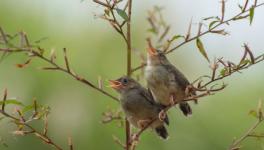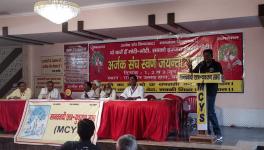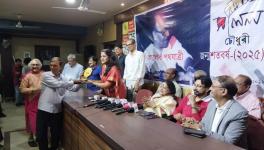The Casteless Collective: Musicalising Anti-Caste Conscience

During the early 1990s, through independent songs and albums, a new genre of pop music stepped into India. For the first time, it introduced shades of hip-hop and rap. By and large, these songs were produced by the savarna imagination. It borrowed production styles and ideas from the American musical scene, which at the time was heavily influenced by MTV.
A cursory glance at these videos testifies to this: these new songs and albums share with Bollywood a slick production style, a totally apolitical approach, lethargically romantic lyrics and also their lyrics. Though the genre was influenced by and imitated the West, the savarna singers and musicians collectively failed to use the strengths of hip-hop and rap. They missed the purpose of hip-hop and rap.
While these songs and albums appropriated rap and hip-hop, they went all-out to concurrently misunderstand them. They made listeners feel that hip-hop and rap are just another genre, with no connection to politics or the history of the exploited. These savarna musicians had the right instruments and access to world music, but what they did not—and will never—have the experience of being oppressed and exploited. Thus the music that came into their hands lost all its vigour.
Also read | Shindeshahi: Music More Important than Philosophy
Yet, the influence of this popular musical fare on a generation cannot be denied. It shaped the musical memory, understanding and language of those who grew up listening to these songs and watching the accompanying videos. This generation of listeners was made to believe—but in what?
The French economic and social theorist Jacques Attali notes in his prophetic commentary on music, NOISE: The Political Economy of Music, published in 1985 by the University of Minnesota press: “…make people believe. The entire history of tonal music, like that of classical political economy, amounts to an attempt to make people believe in a consensual representation of the world. In order to replace the lost ritualisation of the channelisation of violence with the spectacle of the absence of violence. In order to stamp upon the spectators the faith that there is a harmony in order. In order to etch in their minds the image of the ultimate social cohesion, achieved through commercial exchange and the progress of rational knowledge.1
Yet, Attali would surely reformulate some of his arguments, were he to dig deep into the treacherous history of music in India. Music, in a society of caste(s), is also a medium to ostracise and exclude, to thwart ambitions to manifest ones being through music.
Attali speaks of a framework of the ‘consensual’ representation of the world, but he would have had to acknowledge, in India’s context, that “social oppression” has never been the agenda of songs here. In the name of Bollywood songs and indie-pop, the dalit-bahujan listeners have been fed with ideas and tastes of the anti-dalit/bahujan imagination of brahmanism. The violence of Indian society has been displaced into these songs, which are replete with fantasies and the romanticisation of love. Since the brahmins have kept music in their custody in India, they were able to present it as sacred. In this way they have made non-brahmin people subscribe to their idea of the world. This first mutilated the organic roots of music and subsequently murdered it.
The Casteless Collective, or TCC, is an original musical phenomenon in India, arisen now to represent its resurrection from this musical death.
“Your forefather kept mine oppressed
Isn’t that why we are given our quota?
Don’t be so proud because you get all you want
Unlike our ancestors we won’t remain calm..” (translated from the Tamil original.)
This song, titled Quota, has been produced by TCC. It declaims on the history and rationale of ‘quotas’ which we colloquially call ‘reservation’, and which are an entitlement of the dalit-bahujans.
Also read | Dalit Women as Active Participants in Ambedkarite Movement
TCC is unique in that all its songs are filled with history and politics. They are also finely produced, fusing technology and tradition. They impregnate minds with new ideas and fresh thoughts, and thus they mark the progress of rational knowledge.
TCC started in 2017, the brainchild of Tamil movie director Pa. Ranjith, with dalit-bahujan artists, singers, rappers, musicians and lyricists. It is producing music at a time of explicit state violence in the country. Alongside, there is unbridled proliferation of technology. What has proved totally revolutionary to the musical traditions of the country is TCC’s collaboration with Gaana music artists, who are also part of the Collective.
(In Tamil land, Gaana music is played and performed during funerals. The performers are members of socially excluded castes.)
Over the years, the music-caste relation has stigmatised an array of musical and performance styles in India. Singers and musicians engaged in the Gaana tradition are not held in great esteem by brahmanical listeners. These musicians also face caste discrimination, although their music is organically produced, has a mystic rawness and provides society a vital artistry that can wake it from the torpor induced by the romantic imagination. This is especially vital while much of the country is afire with social strife.
Music has not entered the lives of exploited people recently. It is in fact the only organic medium available to them which offers some consolation from suffering. When music became “organised sound” in the modern times, it also became inseparable from instrumentation and technology. Hence it was transformed into a commodity. Those who controlled the means of producing music became its masters—even when they created music that had never belonged to them at all.
In India, brahmins from all linguistic regions commodified and hegemonised music through film, private performances and, recently, albums. In their music, the dalit-bahujans lose their rootedness and their organic association with nature.
TCC has re-acquired for the dalit-bahujans their means of musical production and with it has changed the purpose of music itself. Brahmanical music veils the larger truths of our society which TCC unveils, daringly so. TCC songs roar out their melodies and words, but they heal us intellectually while doing so.
For example, Vivasayam, a song about the sufferings and dreams of farmers, has been produced with a vigour and powerful imagery that has perhaps never been seen before. We hear it, see it, and enter that world of musical imagination which we have been purposefully steered away from. Its lyrical and image elements are impossible for a brahmanical imagination to conceive of.
“We will farm in peace
When we buy land in Outer Space
This is no place for us
No one to wipe a farmer’s tear.
Our legs have tread and toiled
On this parched land,
Mother Earth found nourishment
Thanks to the cracks on our feet…..”
Attali says that music, “in its ambivalence, in its all-embracing hope, is simultaneously heard, reasoned, and constructed. It brings Power, Science, and Technology together. It is a rootedness in the world, an attempt to conceive of human creation as being in conformity with nature.”2
Also read | How Bhimrao Kardak and His Troupe Brought Ambedkar in Song
When music went into the hands of the brahmins, this hope, reason, power, science and technology, this rootedness, was turned completely upside down. True that the power that comes with marshalling science and technology was exercised by the brahmins, but in their music the truth was erased and the connection of human beings with nature was disrupted. Vivasayam, re-establishes this connection and makes the element of truth an essential element of every musical composition.
TCC has also produced songs on Ambedkar, women’s exploitation, the culture of consuming beef curry and so on. All these subjects never appeared in the musical inspiration of the country with such intensity, nor has it ever produced such fine visual elements. Yes, it includes Gaana music, accompanied with the instruments and the history that have been ‘outcasted’, but rap is also an integral part of their repertoire.
Fusing many genres of music and history, TCC provides the musical imagination that we need in our isolation.
The purpose of music is not to set us further adrift from the world, but to integrate us with it. TCC’s music makes us uncomfortable. It wakes us up from the lethargy of romanticism. It is the kind of phenomenon that is certain to help us build an anti-caste sensibility.
Get the latest reports & analysis with people's perspective on Protests, movements & deep analytical videos, discussions of the current affairs in your Telegram app. Subscribe to NewsClick's Telegram channel & get Real-Time updates on stories, as they get published on our website.
























